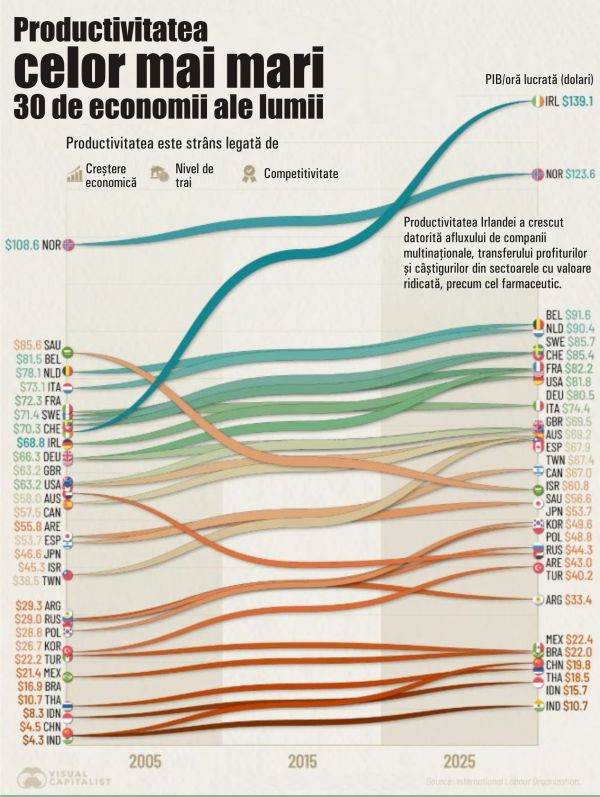Advanced countries tend to dominate the world's economic productivity rankings, but some emerging markets have also made major gains as they industrialize and integrate into global supply chains, according to an analysis by visualcapitalist.com, which ranks the world's 30 largest economies by GDP per hour worked (in dollars), revealing where output has grown or stagnated over the past two decades.
Economic productivity, measured by the value of goods and services produced per hour worked, is a key indicator of overall efficiency and prosperity.
Data for this ranking is provided by the International Labor Organization (ILO).
• Ireland's exceptional productivity growth
Ireland leads the way in productivity growth, with hourly output rising 102% from $68.8 in 2005 to $139.1 in 2025. However, much of this is statistical, not structural, according to the cited source.
The presence of global tech and pharmaceutical giants such as Apple, Google and Pfizer inflates Ireland's GDP figures through profit shifting and intellectual property accounting.
• China's growth slows but remains solid
China's productivity rose from $4.5 per hour in 2005 to $19.8 in 2025, indicating a gain of over 340%. The early 2010s brought massive efficiency gains as factories modernized, infrastructure expanded, and production became more sophisticated. However, growth has slowed in recent years. As wages rise and manufacturing matures, further productivity improvements increasingly depend on automation, the integration of artificial intelligence, and innovation in the service sector.
• Mixed trends in oil-producing countries
Productivity in Saudi Arabia fell from $85.6 in 2005 to $56.6 in 2025. The decline reflects both the decline in oil prices in the 2010s and the OPEC+ production cap, which has reduced the amount of oil extracted. While diversification efforts under Vision 2030 are expanding non-oil industries, hydrocarbons still dominate the economy.
In contrast, Norway, another resource-rich economy, maintains one of the highest productivity levels in the world, at $123.6 per hour, thanks to strong governance, reinvestment of sovereign wealth, and a highly skilled workforce.
The United States, Germany, and France all recorded steady increases. The United States rose from $63.2 in 2005 to $81.8 in 2025, Germany from $66.3 to $80.5, and France from $72.3 to $82.2 over the 20-year period.
Western Europe continues to outperform in terms of efficiency thanks to automation and worker training, while Japan and the United Kingdom have grown more slowly due to aging populations and stagnant investment.




























































